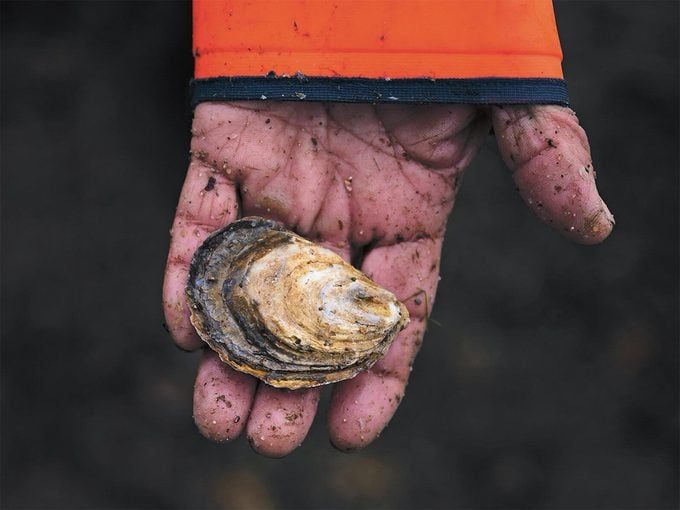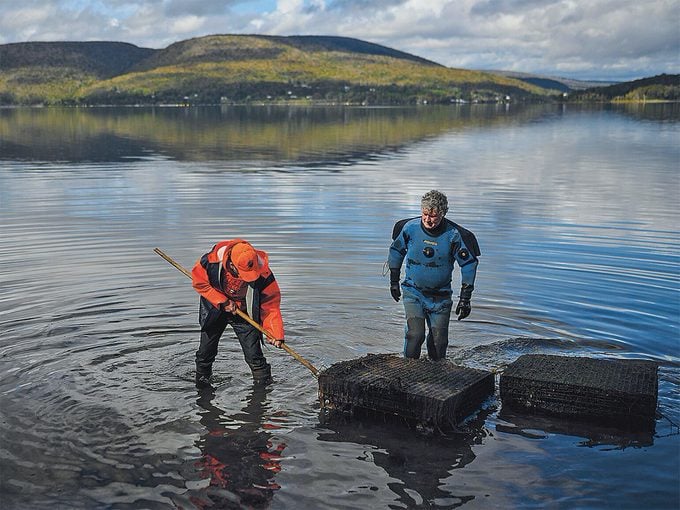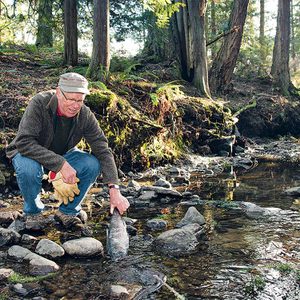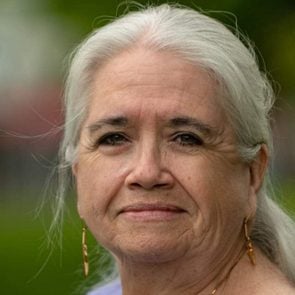Inside the Race to Save Cape Breton’s Oysters From a Parasite
A mysterious parasite is killing Cape Breton’s oysters. Now scientists and Indigenous harvesters may have discovered a solution to save them.

THE DEAD OYSTER falls from the plastic mesh bag with the hollow clop of a horse hoof on pavement. Its shell gapes, innards rotted. About 100 more oysters—some living, some dead—quickly follow, falling on the flattened bow of Joe Googoo’s dark-green metal johnboat. Clad in a jacket with blaze-orange sleeves and a ball cap, Googoo pulls a knife from his belt holster and taps the oyster shells with its curved tip as he sorts through the mottled pile. Counting them one by one, he tosses the lifeless shells aside and puts the living oysters back in the bag.
Robin Stuart, a large, curly-haired man in a tattered black-and-blue dry suit, perches on the boat’s edge. Stuart, one of Nova Scotia’s most experienced aquaculture experts, cracks jokes as he, too, picks around for “morts”—mortalities caused by the oyster parasite MSX. But as the long-time friends tally the dead, Stuart soon grows sombre. “There’s almost as many morts as there are live,” he says. “MSX is definitely doing its thing here.”
Bras d’Or Lake, cupped within Nova Scotia’s Cape Breton Island, is a sprawling, ocean-linked tidal network of bays, estuaries and ponds. On its muddy bottom, Crassostrea virginica oysters once grew as big as brunch plates, with frilly shells and deep, round cups: qualities prized by oyster connoisseurs. Filter-feeding oysters grow in salty ocean waters and have hard, calcium-based shells that protect soft innards: heart, gills, stomach and other organs. For decades, Cape Bretoners picked oysters from public beds while commercial growers cultivated the shellfish in vast beds on the lake’s bottom and transferred them onto floating rafts to await packing and shipping.
Many harvesting families, including Googoo’s, are Mi’kmaq, and have lived near the Bras d’Or—which they call Pitu’paq, or “to which all things flow”—for thousands of years. Oysters are a fundamental part of Mi’kmaw food traditions and philosophy, with many families harvesting them year-round for personal consumption. So when the commercial oyster industry took off in the 1950s, many were well positioned to sell oysters for a living. At the industry’s peak, estimates Stuart, more than 100 Cape Breton license holders—commercial and recreational, Mi’kmaq and non-Indigenous—had millions of oysters on their farms, collectively worth millions of dollars. Then it fell apart.
IN THE SUMMER OF 2002, a mysterious and deadly invasive parasite called multinucleated sphere unknown, or MSX, flattened Cape Breton’s oyster industry. Within months, millions of oysters died, their internal organs devoured by the parasite. Mortality of infected oysters hovered around 90 per cent. Nearly all of Googoo’s 400,000 oysters rotted.
“It was devastating,” says Anita Basque, who at the time was fisheries manager for Potlotek, a Mi’kmaw community on the Bras d’Or’s south shore. Growing up, she helped Googoo’s father sell shucked oysters, packaged in glass jars, at the Googoo family’s shop. Later, as a single mother, she supported her three children with money she made diving for and selling oysters, before she became a bank teller.

When Basque eventually took over as her band’s fisheries manager, she met Stuart, who was already well respected in Nova Scotia’s aquaculture scene and helped secure oyster leases for the band. A new oyster processing facility, initiated by Basque, launched in 2002 with a grand celebration; within months, the industry collapsed due to MSX.
Cape Breton oysters are no longer sold commercially, and the industry has been essentially dead for nearly two decades. Now, in a last-gasp effort to revive commercial oyster growing in the Bras d’Or, a makeshift team of scientists, community members and oyster harvesters is fighting to understand and evade MSX. Coordinated by Cape Breton University biology professor Rod Beresford, theirs is a supergroup of sorts, relying on high-tech devices, traditional knowledge and elbow grease. It’s a collaboration Basque calls “true reconciliation,” with non-Indigenous experts helping their Indigenous neighbours confront a painful, concrete problem. And what they’ve found so far could bring the Bras d’Or oyster industry back from the dead.
ON THE GROUP’S SECOND DAY of fall sampling in October 2020, Beresford and his colleague, Sindy Dove, join Stuart at a chilly beach on the north side of the Bras d’Or, far across the lake from Googoo’s leases. Stuart and Dove scramble along the beach toward a buoy marking the site’s four cages: two floating near the top, two resting on the murky bottom. Beresford doesn’t eat oysters and has never been particularly interested in them. But he is interested in solving scientific mysteries.
For decades, the behaviour of MSX and how it arrived in Canada have been a “real head-scratcher,” says Beresford. Some biologists believe that the parasite first hitched a ride to North America in the ballast water of U.S. warships returning from Japan and Korea after the Second World War. Scientists first identified MSX in Delaware Bay, south of New Jersey, after it wiped out thousands of oysters there in 1957. Within decades, it spread, infecting oysters from Maine to Florida. On how the parasite made it to Cape Breton, Beresford says there are two theories: it arrived either in ballast water or via an infected oyster introduced from farther south.
Viewed under a microscope, MSX is “almost a perfect circle, like an emoji face,” he says. When eaten, it’s harmless to humans. But once MSX infects an oyster, the parasite quickly starts to consume the creature’s soft innards. When an oyster loses its digestive organs, it essentially starves to death. Because oyster immune systems don’t have a “memory,” a weakened oyster that survives its first MSX infection is more likely—not less—to die from a subsequent infection.
As Beresford pondered the puzzle of the oysters, eventually connecting with Indigenous knowledge holders including Googoo and Basque, he formulated his theory: perhaps the lake’s muddy substrate is exactly where MSX lurks. And perhaps certain, specific salinity levels and temperatures, which vary widely, either help or hinder the parasite. If he could keep oysters alive just below the lake’s surface using modern aquaculture gear, he speculated, maybe he could prevent them from catching the parasite in the first place.
With Stuart’s expertise and cooperation from leaseholders who had held onto decades-old historic leases, Beresford and the team chose a dozen test sites across the Bras d’Or. Googoo, who, after MSX hit, used floating mesh bags to grow thousands of his own oysters in a protected bay, grew 24,000 baby oysters for the project. In the late spring of 2019, the team packed each cage with 500 oysters, zip-tied temperature and salinity data loggers resembling large black glow sticks to the plastic mesh, and then, sank two cages to the muddy bottom and floated another two near the surface at each test site. They waited a year as the oysters grew.
STUART’S WORK COUNTING dead oysters and taking samples, on that misty morning with Googoo on the Bras d’Or, will provide the first glimpse of whether Beresford’s theory holds. At two of the sites, oyster mortality at the bottom hovers between 40 and 60 per cent. Yet today, only around one to two per cent of oysters floating near the surface have died. The difference, Googoo says, validates what he’s been insisting all along: that oysters can survive in the Bras d’Or when floated in the right locations.
Beyond the promise of reviving a culturally important Mi’kmaw tradition and a critical component of their lake’s ecosystem, the project is also an act of amity. Basque and Googoo later tell me that working with Beresford’s team has been refreshingly devoid of the condescension and sidelining they often experience from non-Indigenous academics and so-called experts. “They’ll listen to me and my ideas,” Googoo says. “I’m the one out in the field every day, not them.”
Mi’kmaw fishers have reason to be wary. In late 2020, they were met by protests when they exercised their federally protected rights by catching and selling lobster outside of the non-Indigenous commercial season. On the province’s South Shore, there were instances of violence and vandalism.
Frequently, Beresford fields questions about his work from other university researchers, who say they admire the trust and camaraderie he’s earned from his Mi’kmaw collaborators. Basque often hears the same thing, but is baffled why others find the relationship so elusive. “It all comes down to respect,” she says.
Although his team is behind on analyzing tissue samples—their testing is currently stalled by a lack of consumables needed to complete the research—Beresford says initial results show a “solid trend” of survival among surface-floated oysters. And as his team draws closer to pinning down the ideal temperature, salinity and depth for avoiding the parasite, one exciting prospect is that their findings could help other areas hard hit by MSX, including the eastern United States. Most importantly, Beresford says, it means they are finally getting closer to helping people like Googoo and Basque realize their long-deferred dream of reviving the Bras d’Or oyster industry—backed by science, and hopefully built to last.
Next, discover how the North invented the science of parkas.
© 2021, Karen Pinchin. From “Freeing Oysters From a Parasite’s Hold,” Hakai Magazine (June 15, 2021), hakaimagazine.com






